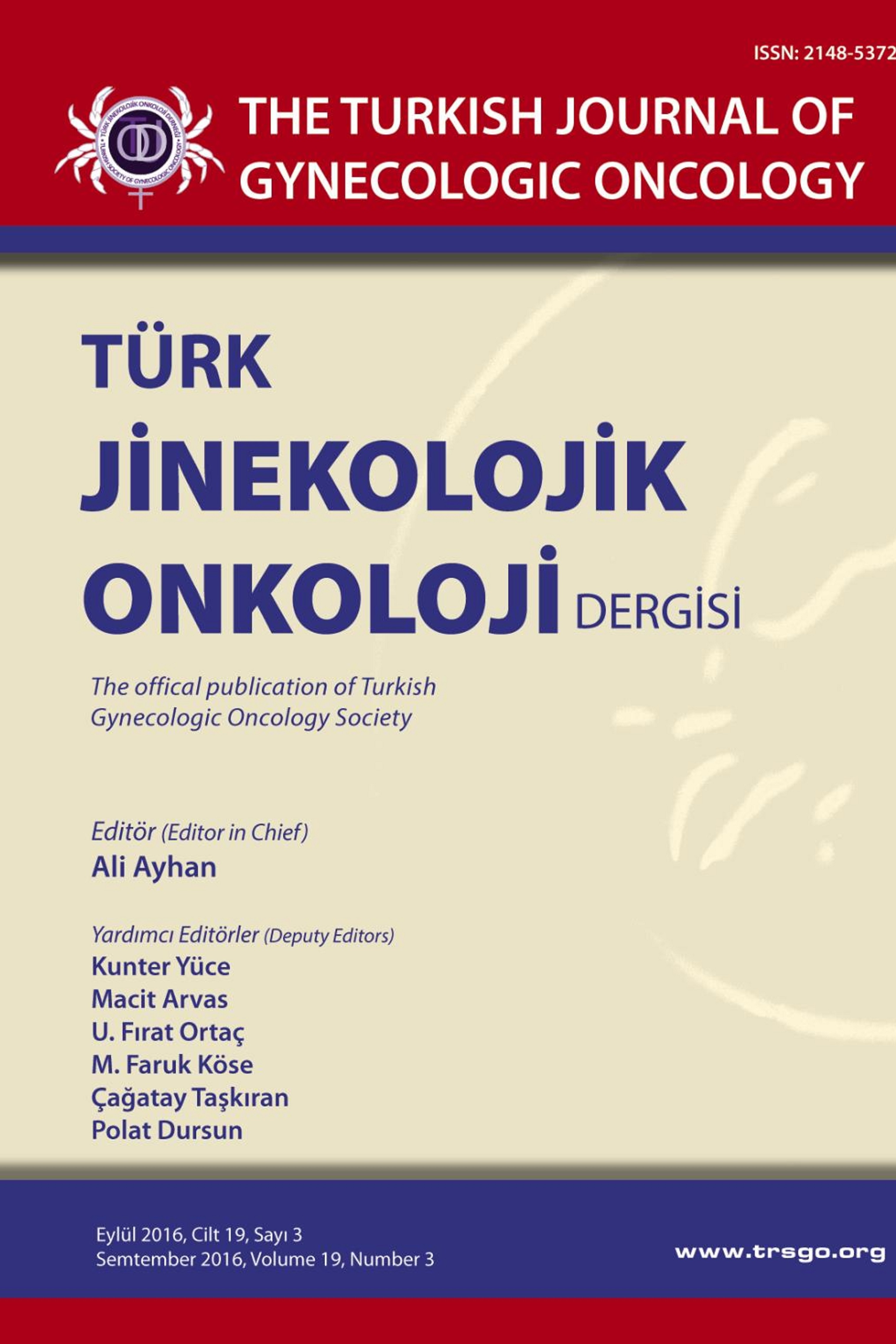POSTMENOPOZAL HASTADA ENDOMETRİUMUN KEMİK METAPLAZİSİ: NADİR BİR OLGU
Amaç: Endometriumun kemik metaplazisi, 20-40 yaşları arasında seyrek olarak görülen, genellikle geçirilmiş abortus ile ilişkili, sekonder infertiliteye neden olan iyi huylu bir lezyon olup postmenapozal hastalarda görülmesi oldukça nadirdir. Burada dört küretaj öyküsü olan ve postmenapozal kanama şikayeti ile başvuran 55 yaşında bir hasta sunulmaktadır. Ayırıcı tanıda, klinik ve patolojik olarak maligniteden ayırım önemlidir. Olgu sunumu: 5 yıldır menopozda olan 55 yaşındaki hasta, vajinal kanama şikayeti ile hastanemize başvurdu. USG'de kavite içinde kemik ile uyumlu hiperekojen akustik gölgeler, probe küretaj materyalinde endometrium stroması içinde kemik dokular tespit edildi. Kan kalsitonin, PTH, Vit D3, kalsiyum, iyonize kalsiyum ve fosfor düzeyleri normaldi. Küretaj sonrası çekilen MR'da endometrial kavite içinde kemik ile uyumlu olabilecek rezidüel partiküller tespit edildi. Histerektomi materyalinin makroskopik ve mikroskobik incelemesinde kavite içinde kemik lamelleri saptandı. Tartışma: Endometriumun kemik metaplazisi patogenezinde çeşitli teoriler ortaya atılmakla birlikte bugün en kabul gören teori, endometrial stromal hücrelerin osteoblastlara dönüşümüdür. Endometrial kavite içindeki kemik dokular genellikle ultrasonografi ile tanınır. Probe küretaj hem tanının kesinleştirilmesi, hem de tedavi için seçilecek en az invaziv yöntemdir. Kemik partiküllerinin çıkarılması ile çoğu vakada spontan gebelik sağlanır. Burada sunduğumuz olgunun dikkat çekici özellikleri, nadir görülen bir patoloji oluşu, hastamızın literatürdeki ikinci postmenopozal hasta olması, postmenapozal kanama şikayeti ile başvurması ve sonuncusu 20 yıl önce olan dört küretaj hikayesinin bulunmasıdır.
Anahtar Kelimeler:
Endometrium, kemik metaplazisi, ektopik intrauterin kemik
Aim: Osseous metaplasia of the endometrium is a rare benign condition that causes secondary infertility in women between 20 and 40 years of age, with a recent history of abortion. It is extremely rare in postmenopausal period. Here, we report a 55 years' old postmenopausal woman presented with vaginal bleeding, with a history of four previous curettages. It is important to exclude malignancy, clinically and pathologically, in differential diagnosis. Case report: A 55 years' old, five years' menopausal woman was admitted with vaginal bleeding symptom. Hyperechoic acoustic shadows were observed in the endometrial cavity in ultrasonography. There were bone tissue in the endometrial stroma in the histopathological evaluation of the probe curetting. Serum calcitonin, PTH, Vit D3, calcium, ionized calcium and phosphorus levels were in normal ranges. MR, following curetting, revealed residual bony particles within the endometrial cavity. Macroscopic and microscopic examination of the histerectomy material revealed bone in endometrial cavity. Discussion: There are different theories for the pathogenesis of osseous metaplasia of the endometrium. Today, the differentiation of endometrial stromal cells to osteoblasts is the most accepted one. It is generally recognised by ultrasonography. Probe curettage is the least invasive procedure for the diagnosis and treatment. Spontaneous pregnancy is generally obtained with the removal of bone fragments from the cavity. The remarkable features of our case are, the rarity of endometrial pathology, the postmenopausal status of our patient that is the second in the literature, vaginal bleeding symptom and history of four curettages, which the last one is 20 years ago.
Keywords:
Endometrium, osseous metaplasia, ectopic intrauterine bone.,
- ISSN: 2148-5372
- Başlangıç: 2014
- Yayıncı: Türk Jinekolojik Onkoloji Derneği
Sayıdaki Diğer Makaleler
DÜNYADA VE TÜRKİYE’DE JİNEKOLOJİK ONKOLOJİNİN TARİHÇESİ
İLERİ EVRE UTERİN KARSİNOSARKOMDA UZUN SÜRELİ HASTALIKSIZ SAĞKALIM
Hasan YÜKSEL, Selda Demircan SEZER, Mert KÜÇÜK, Nil ÇULHACI, Muhan ERKUŞ
KADIN SAĞLIK ÇALIŞANLARININ SERVİKAL KANSERE İLİŞKİN BİLGİ VE TUTUMLARININ BELİRLENMESİ
Nasuh Utku DOĞAN, Çetin ÇELİK, Özlem Seçilmiş KERİMOĞLU, Aybike PEKİN, Hasan TALAŞ
POSTMENOPOZAL HASTADA ENDOMETRİUMUN KEMİK METAPLAZİSİ: NADİR BİR OLGU
